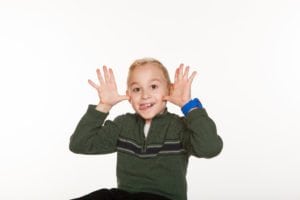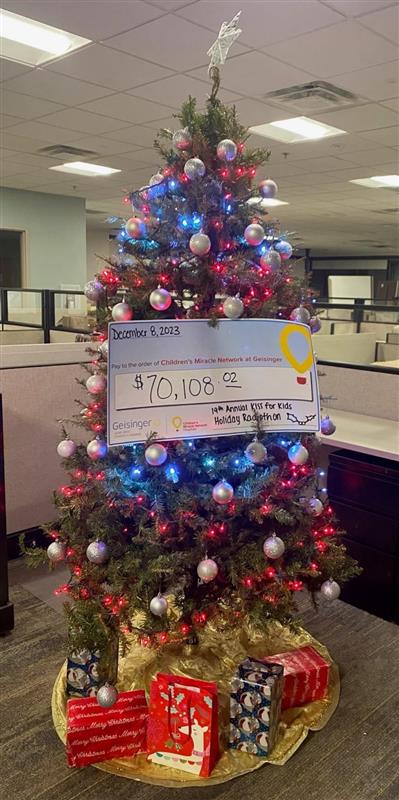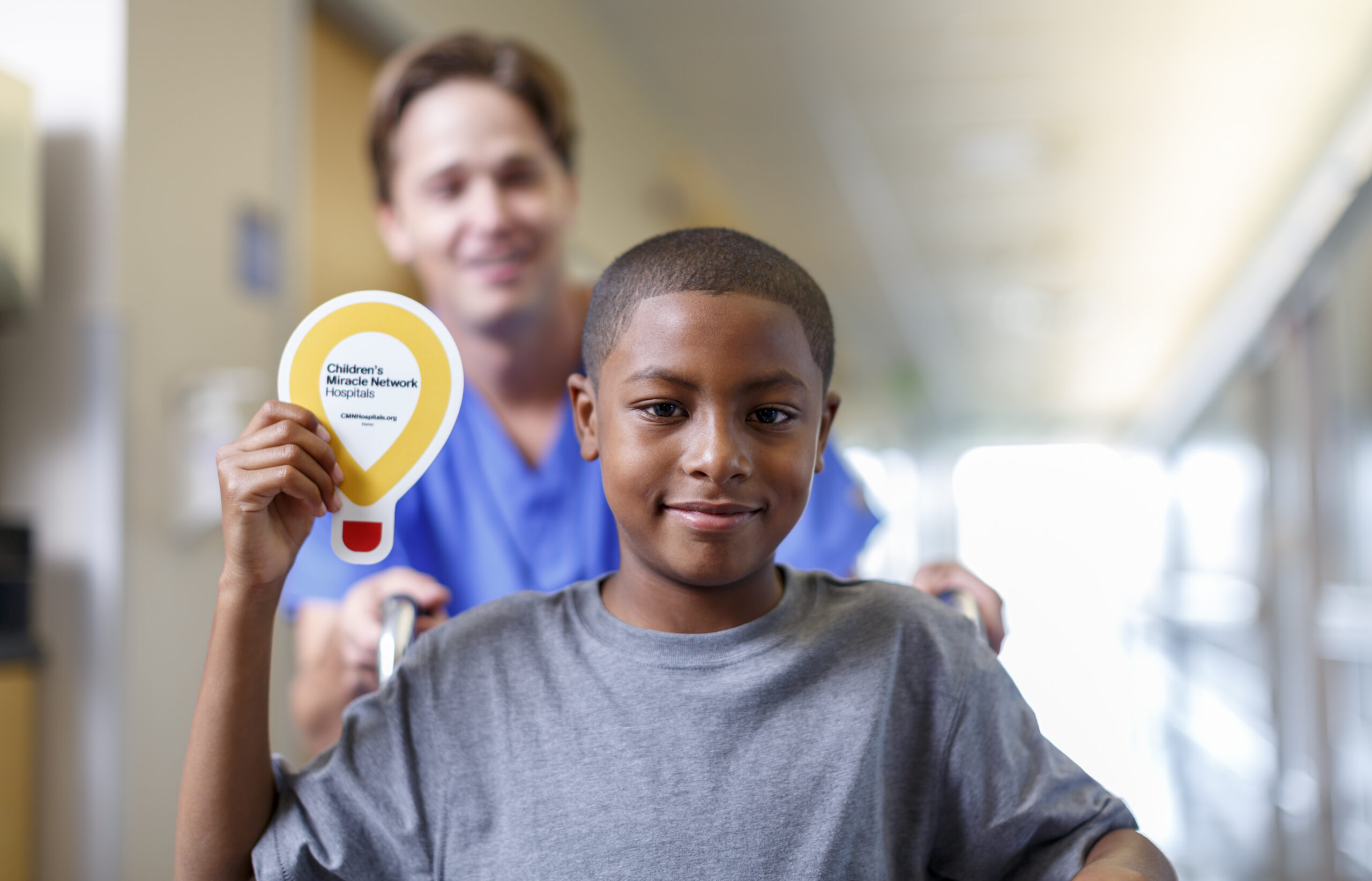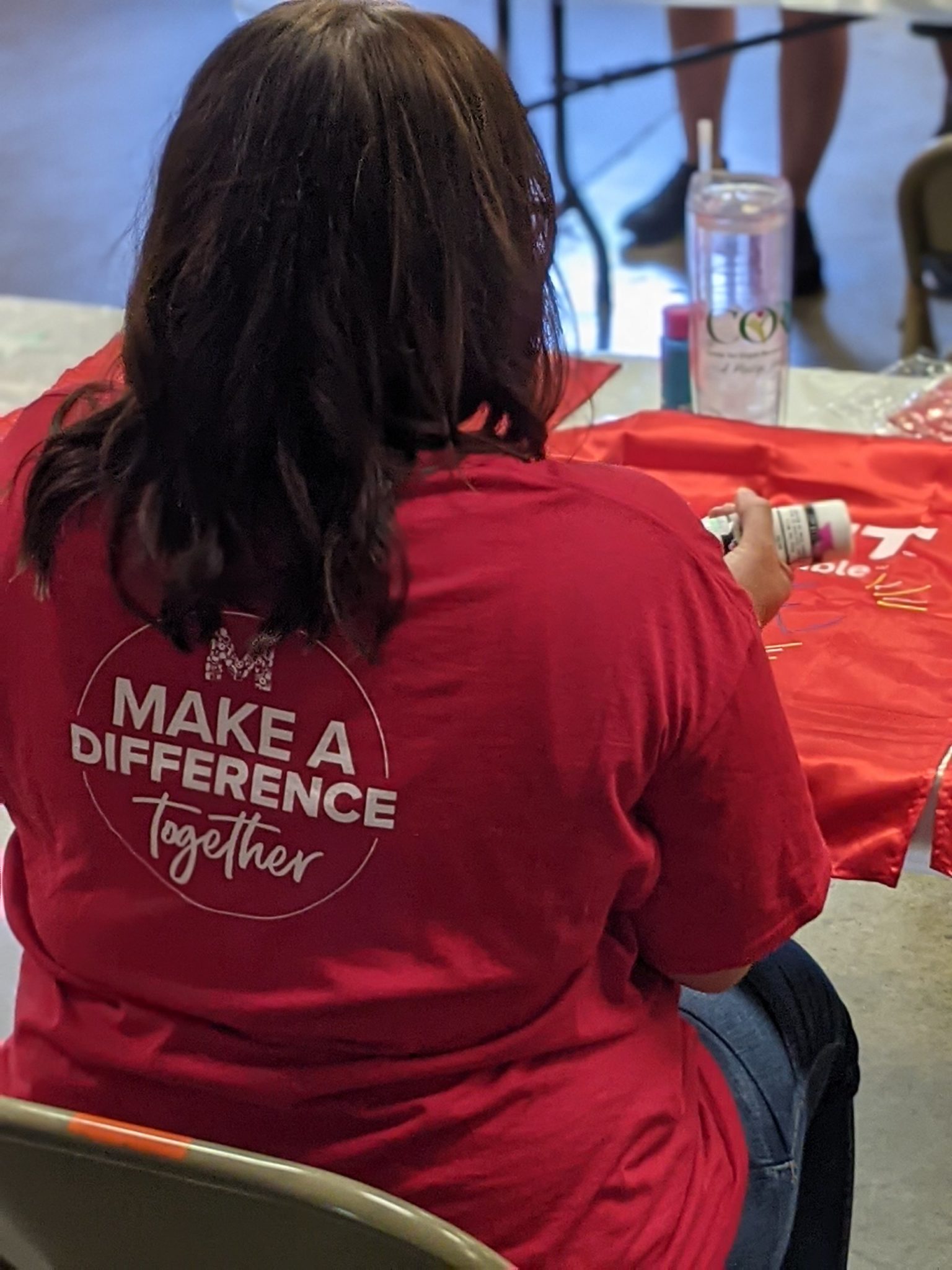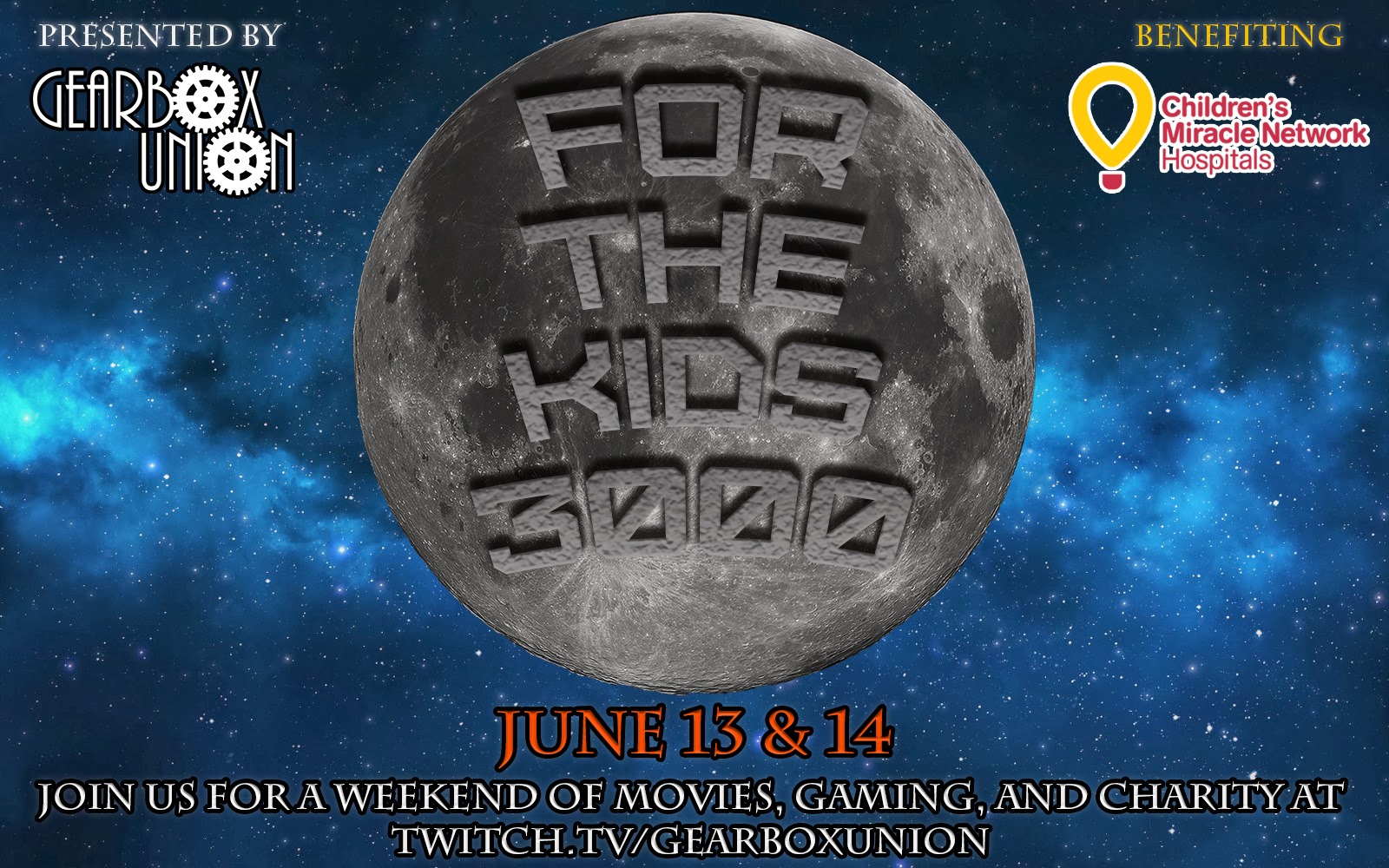Meet 2017 Miracle Kid Kieran Clare

Nine-year-old Kieran Clare gingerly makes his way across the playroom floor of his home. He moves carefully, trying to be surefooted while maneuvering around the room. He pivots to turn and falls to the floor, toppling backward near a shelf of board games and toys.
“What do we do when we fall down?” his mother Beth asks, while watching his smile turn to an embarrassed smirk.
“We get back up,” Kieran confidently exclaims.
With determination, Kieran carefully gets his balance in a kneeling position and slowly forces his body to standing. He smiles big and gives two thumbs up for the camera waiting to take his picture.
For the Clare family, overcoming adversity and getting back up after a fall is what they have always done.
Beth and her husband Brian were proud parents of two children, Sean, now 16, and Kayla, now 14, when they found out Beth was pregnant with twins, Liam and Aiden, now 11. Not long after the twins birth, Beth learned that she was pregnant again with twins, but she miscarried.
After overcoming the disappointment of the miscarriage, a few months later they learned they were expecting again and were surprised that they were having triplets.
Thirty weeks into that pregnancy, Beth had a placenta abruption, a condition in which the placenta partially or completely separates from the uterus. The condition can deprive babies of oxygen and nutrients, and cause severe bleeding. The babies had to be delivered immediately.
For two of the triplets, Angela and Fiona, the complication only met a slightly premature birth. But for Kieran, the effects were detrimental. At birth, doctors thought Kieran had failure to thrive because he was smaller than his sisters. Soon after, Beth and Brian began noticing other issues in Kieran’s development.
Around 10 months when his sisters were moving around and showing good signs of development, Kieran wasn’t eating properly and was very stiff. His parents noticed he would drag his legs behind him when moving.
“Changing his diapers was very difficult because his legs had become so stiff,” Beth said. “It was difficult to get his legs separated to put him in a diaper.”
He was referred by the family pediatrician to see a neurologist at Geisinger Janet Weis Children’s Hospital.
When Linda Famiglio, MD, pediatric neurologist met Keiran at nearly 18 months old, she knew immediately that he was suffering from cerebral palsy with spastic diplegia.
Cerebral palsy (CP) is a neurological disorder caused by a non-progressive brain injury or malformation that happens while the child’s brain is developing. Cerebral palsy primarily affects body movement and muscle coordination.
Spastic diplegia is one of nine types of CP with the most common problem being muscle stiffness. It usually shows up during infancy and early childhood. Spastic diplegia affects the legs and arms, making them stiff and contracted. The legs are generally affected more than the arms. This makes crawling and walking difficult and some children may not be able to walk at all.
On top of this diagnosis, Kieran also was suffering from lack of nutrition.
“He had no fat on his body and was having trouble eating because of the CP,” Dr. Famiglio said. “We made him an appointment to place a feeding tube and got him started on physical therapy and some stretching that his mother could do with him.”
Kieran began to thrive with the feeding tube. As he put on weight, his development improved.
“He acted as though he didn’t have time for a disability. He wanted to keep up with his brothers and sisters. If they were outside playing, he was outside with them,” Dr. Famiglio said. “Due to the stiffness, he couldn’t walk but he kind of commando crawled his way around with his siblings.”
But Beth wanted better for her son. She continued to work with him, stretching his legs to give him improved mobility. She worked with Dr. Famiglio and the Geisinger pediatric physical therapy team to find solutions to help him be more mobile and less stiff.
“He really wasn’t able to move from the waist down,” Beth said. “He had a walker, but it had a full harness that held him up. It was a lot of work to get him strapped in and lifted into the walker.”
Doctors had prescribed different medications to help Kieran deal with the stiffness of his legs, but a lot the medications left him dazed and unable to move.
“It was a strong medication that loosened him up a bit, but he really wasn’t able to move,” Beth said. “He had no muscle strength and while on the medication, he would be really spaced out. He passed out in class once and I got a call from the school nurse saying they couldn’t wake him up.”
Beth worried about Kieran’s quality of life and continued to look for other solutions. When Kieran was 4, Beth found out she was pregnant once again and soon they had their youngest child, Declan, now 5. While taking care of her school-aged kids and providing special care to Kieran, Beth was now caring for a newborn.
But within the next year the unthinkable happened – Brian unexpectedly passed away, leaving Beth to raise her eight children alone. Somehow Beth managed, continuing to care for all of her children, while also taking care of Kieran’s special needs.
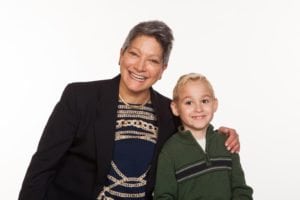
Kieran was still unable to walk and carrying him was extremely difficult because of the stiffness in his legs.
“Stretching him was like breaking bones. He couldn’t be toilet-trained, because he couldn’t stand or sit really well,” Beth said. “He was so stiff, like a board.”
Beth continued to look for alternatives to the medication. Doctors tried different medications, but they all had undesirable side effects. She looked at several different surgical options, while she continued to work Kieran with physical and occupational therapy, constantly stretching his legs.
“I started seeing Kieran at 2-½ years old,” said William Mirenda, MD, chief of Pediatric Orthopaedics. “We emphasized to his mother how important it was to continue therapy and work with the stretching. Mom has done a phenomenal job of maintaining his motion. He eventually got to the point that he could walk with braces on and with a walking frame that supported him allowing him to take steps.”
Dr. Mirenda explained that there were orthopaedic surgical options to loosen tight muscles. But Kieran had so many muscles that were tight that it would not be possible to operate on each of them. He also said muscle tendon surgery on a child so young likely would only be a temporary help and Kieran would likely outgrow the benefits. If orthopaedic surgery could be delayed, it could more likely provide lasting benefit and not require repeat surgery.
Beth continued to research different surgeries until she read about one used for kids with Kieran’s diagnosis. It was procedure done on the lower spinal cord called a dorsal rhizotomy. Through her research, she found that only two doctors in the state had performed the surgery — one of those being Geisinger Janet Weis Children’s Hospital’s Amir Kershenovich, MD, director of Pediatric Neuorsurgery. Beth asked Dr. Mirenda for a referral to Dr. Kershenovich to determine if Kieran might be a candidate for the surgery.
“It is not a common procedure. I have only performed a couple here at Geisinger,” said Dr. Kershenovich. “Many providers are not aware that we can do the surgery. Also there is a doctor in St. Louis who has refined the technique and gets referrals from all over the world.”
Dr. Kershenovich examined Kieran, then 7, and went over the risks of the surgery with Beth, including the possibility that Kieran could be left paralyzed or incontinent.
“Dr. K. explained things to me that I had not even thought about. He told me to take time to make the decision and didn’t pressure us into having the surgery,” Beth said. “For Kieran and I, we didn’t see it as that big of a risk. Like any paralyzed person he already had no use of his legs and the way things were going, he was going to be in diapers the rest of his life anyway.”
The surgery was scheduled for Feb. 2, 2015, but on the day of the surgery there was a bad snow-storm in the East Stroudsburg area. Roads were being closed, including eastbound Interstate 80.
“I went out and shoveled, came inside and went back out and the snow was piled up again. I wasn’t sure if we were going to make it,” Beth said. “I called and spoke to a resident, who told me they could only hold the surgery for an hour. So we started driving through the snowstorm. On our way Dr. Kershenovich called my cell phone and said, ‘Take your time. When you get here, let us know.’”
When they arrived in Danville, it was sunny and the roads were clear — and Dr. Kershenovich was waiting to perform the surgery.
It was an eight-hour procedure, Dr. Kershenovich made a small incision in Kieran’s lower back, where all the nerves come out of his spinal cord at what is called the “horsetail.” He used electrophysiological monitoring for nerve stimulation to identify the nerves for his legs.
“We have to identify which nerves are which because if we cut nerves that are not involved, the patient could be left with deficits,” Dr. Kershenovich explained. “With the rhizotomy there are 10 different nerves, 5 on each side.”
Dr. Kershenovich needed to identify the sensory and motor parts of each nerve. The surgery requires cutting two-thirds of the sensory part of the nerve before it exits to the muscles. By cutting some of the sensation, it allows the muscles to relax.
“There is a lot of assessing of the nerves with electricity,” Dr. Kershenovich said. “You touch the nerve to separate the motor from the sensory parts. You touch it again to make sure it is not passing electricity into a muscle and contracting it. Once you are sure of that, that is the portion that can be cut.”
Kieran was facing a long recovery after the surgery — at least six months. He spent a week at Geisinger Janet Weis Children’s Hospital and then was transferred to Good Shepherd Physical Therapy in Allentown. Beth needed help, and had to make decisions for the other children based on their strengths and personalities.
“I decided to pull the twins out of school and have them do cyber-school, because they were kind of falling through the cracks, after their father passed away. I wanted to keep more of an eye on what they were doing,” she said. “I pulled Kayla out when Kieran went into the hospital so that, she could stay home with Declan. It was flu season, and I wasn’t able to bring him up to the unit. She did the school year through cyber-school and was able to keep up. She is very social and a straight-A student. If I took Sean out, he would never leave the house. He is very antisocial so he needed to stay in, because he just started high school at the time.”
Beth would make sure the other kids got where they needed to be and would then travel to the hospital or the rehabilitation center to be with Kieran. Meanwhile, Kieran was making progress. He gained movement in his legs and was able to walk with assistance.
Dr. Kershenovich was very happy with the results of the surgery.
“We were able to reduce the spasticity in his legs significantly,” Dr. Kershenovich said. “After the surgery everything changed for him. It was like he had a new pair of legs — and now he had to learn how to use them.”
Kieran worked hard with rehabilitation and his mother and siblings helped him learn to walk, sit and do all the things he had not been able to do prior to the surgery.
“When he was in the rehab hospital, Sean would tell him if he could walk the whole hallway, he would give him $100,” Beth said. “He would try every night. Finally, he did it for the $100. Now he does it every day. He was walking more in a squatting position and as his legs strengthened, he began being more and more upright.”
Kieran was incontinent for four months after the surgery but after leaving the rehabilitation center and coming home, he began using the toilet. Along with the improvements to his legs, his family also noticed Kieran’s hands were less stiff as well and he was able to use them more effectively.
“He stopped using diapers and he wasn’t constipated any more. He also was able to use all 10 fingers,” Dr. Kershenovich said. “This is interesting, because it has been reported that even though you are operating on the nerves of the lower part of the body, somehow the arms sometimes improve, along with speech. His balance and energy improved, as well.”
“It was life-changing surgery for not only Kieran but the entire family,” Beth said. “He couldn’t sit on a chair without sliding down before the surgery. Now he can actually sit without back support for a longer period of time, which is great, because he can sit at a table at school with all the other kids. The difference is immense. He is more independent and can use the toilet. He can brush his own teeth – before, he couldn’t use his hands that well. It’s amazing how much the surgery has helped him.”
Kieran remembers much of the time he spent in the hospital two years ago, and he and his mother have great stories about their stay in the hospital.
“They always turned on the TV and I played with my stuffed animals, and sometimes I played video games,” Kieran said. “I remember I got to make a ‘Cat in the Hat’ hat.”
“What did you tell me?” Beth asked. “’I love it here, because they let me stay up late and let me eat in bed. And when I push the button, pretty girls come.’”
“I never said that!” Kieran said, trying to hide his embarrassment.
“Yes, you did,” Beth said laughing. “You asked me to bring your cologne.”
It was very important to Beth that Kieran was comfortable at the hospital and felt at home.
“I had to leave him overnight and I never had a complaint out of him. It made me feel better as a single parent leaving him, because I couldn’t stay. I had to be here when the kids woke up,” she said. “It was a really good experience for us.”
Kieran is now able to walk around the house unassisted — only wearing braces on his legs. When he is in a crowd, he uses a cane to help keep his balance. Since he hadn’t used his leg muscles for seven years, a lot of the therapy Kieran continues to have is to build up strength in his legs. He has a special tricycle that he enjoys riding. He also is able to use his legs while swimming.
Like most boys his age, Kieran loves the Avengers.
“My favorite heroes are Thor, Hulk, Captain America and Iron Man,” he says. “I also love Star Wars.”
Kieran’s little brother Declan sees his older brother as a superhero. He follows Kieran around the house and repeats many of the things he says.
“When Kieran came home from the hospital, Declan wanted to sleep in bed with him,” Beth said with a chuckle. “He definitely missed his big brother.”
The future looks great for Kieran and his family, and all of his caregivers agree that with his family and strong support system, he will continue to improve.
“As time goes on and he continues with physical therapy and using those muscles he was not using, he will get stronger and continue improving,” Dr. Kershenovich said. “His mother is an awesome mom, and he got something special back in his life — the ability to walk. He continues to walk better and become more independent and is now able to look people in the eye.”
Dr. Mirenda continues to monitor Kieran’s progress, keeping a close eye on his hips. Children with CP sometimes have issues with their hips because the muscle function around them is less than perfect. In these cases, the ball of the hip tends to make its way out of the socket
“He still has another eight years of growing to do,” Dr. Mirenda said. “There is a chance he will need surgery on his hips. It is not for certain, but I will monitor him until he is fully grown. I will see him every six months until he is all the way grown.
“Kieran did better after his rhizotomy than most kids do,” Dr. Mirenda added. “The biggest plus that Kieran has is that he is bright — he can understand and cooperate. He has a great family that stretches him and makes him exercise. The exact same operation done to a child that doesn’t have a family pushing him like that — they don’t get half of the response [that Kieran had].”
The Clare family couldn’t be more grateful for Geisinger Janet Weis Children’s Hospital and the life-changing surgery that Kieran had.
“We were told he would never walk without use of the walker around him,” Beth said. “He can do so much now and I owe it all to Dr. Kershenovich. He may walk with a limp right now or with the braces on but even then it is a huge difference, much better than being wheelchair bound the rest of his life. He has this total quality of life that he didn’t have before.”
Dr. Famiglio credits Beth for Kieran’s amazing recovery and can’t say enough about the Clare family.
“The prognosis and the future was always bright for Kieran and his family because of the people that they are and their spirit,” she said. “He has a mother and a family who keep finding the most possibilities for him. He is going to exploit them all. He is going to thrive through them all. You have to have the dedication and that kind of spark.
“You know when you say someone has ‘it?’ He’s got ‘it.’ He’s got that ‘it’ thing, where he exploits every possibility that is given to him.”
Kieran has benefited from many services and programs funded by Children’s Miracle Network at Geisinger, including the Child Life Department. Child Life workers helped Kieran with distractions and kept him comfortable while he was in the hospital by providing activities, video games and other things to keep him busy. Kieran also was followed by Dr. Famiglio at Geisinger East Stroudsburg clinic, where Children’s Miracle Network funds were used to help equip the office and provide many of the tools used to help in his diagnosis and care.
